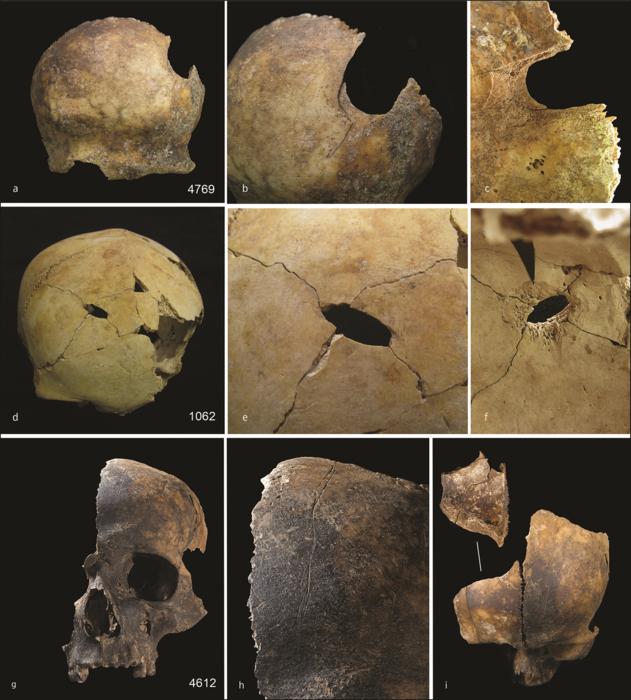The Darker Angels of Our Nature: Brutality of Early Bronze Age Britain Unveiled
In a groundbreaking study revealing the stark realities of interpersonal violence in Early Bronze Age England, archaeologists have unearthed the remains of at least 37 individuals from Charterhouse Warren, Somerset. The analysis of these remains, carrying profound implications about the cultural and social dynamics of that era, suggests the victims suffered violent deaths possibly resulting from a surprising and coordinated attack. The findings, published in the esteemed journal Antiquity, challenge long-held assumptions about the peaceful nature of prehistoric Britain.
The site, a 15-meter-deep shaft, served as a macabre grave where a fusion of men, women, and children were interred under circumstances of extreme violence. Unlike typical burials of the time, the skeletal remains exhibit clear signs of brutal treatment, with blunt force trauma being evident on the skulls. This situation presents a narrative of societal breakdown where communal ties could devolve into acts of brutal dehumanization. Professor Rick Schulting of the University of Oxford, the lead researcher, emphasizes that these discoveries cast a shadow over Britain’s human past, suggesting a cycle of violence that was likely rooted in social conflict rather than mere resource competition or environmental stressors.
From the thorough examination of over 3,000 human bones and fragments, researchers uncovered a plethora of cut marks and perimortem fractures on the skeletons. These signs indicate a deliberate butchering process, leading to the hypothesis that at least some of the deceased were consumed by their aggressors, a ritualistic cannibalism which communicated a message of otherness and promoted a narrative of subjugation. Scholars propose that the act of treating these individuals as less than human was emblematic of a broader societal conflict; it served to ‘other’ them and remove the sanctity often afforded to the dead.
Intriguingly, while there are several archaeological sites across Britain that showcase skeletal remains dating back to this period, direct evidence of violent confrontations is indeed rare. The researchers cite that injuries reflective of violence are more often associated with the Neolithic era in Britain, making Charterhouse Warren’s findings particularly striking. As Professor Schulting poignantly stated, this site illuminates the darker facets of human nature, implicating that perceptions of slights or social grievances could rapidly spiral into catastrophic violence.
In the context of the Early Bronze Age, where large societal networks might typically reflect a relative degree of peace, Charterhouse Warren serves as a shocking anomaly. The mix of individuals found—men, women, and children—suggests that this was not merely a violent clash but rather a calculated assassination that might have stemmed from interpersonal conflicts or societal tensions, possibly exacerbated by contagious diseases, as evidenced by indications of plague found in the remains of two children.
This brutal episode presents an unsettling portrait of a society where the delineation between predator and prey became blurred, exhibiting a penchant for retaliatory violence that echoes through the ages. The absence of any found tools or weapons near the body remains raises questions about the nature of the violence and its perpetrators. Were these victims merely in the wrong place at the wrong time? Or were they specifically targeted due to unresolved feuds or revenge for past grievances?
The nuances of this violence point to a complex social framework where communal relationships were fragile. Scholars hypothesize that intergroup tensions, including theft or personal insults, may have spiraled into violence that was more reflective of deep-seated vendettas than mere survival motivations. The presence of an ample supply of animal bones suggests that resource scarcity was unlikely a driving factor in these acts of violence, rerouting the focus to socio-cultural factors.
As the narrative surrounding Charterhouse Warren unfolds, it becomes a critical avenue for exploring human emotions and societal reactions in the face of conflict. The study highlights that these conflicts were not isolated incidents but potentially part of an ongoing cycle of vengeance that shaped social interactions in Early Bronze Age communities. This realization aligns closely with contemporary human behavior, where grievances can escalate into disproportionate responses and violence.
The ramifications of the findings extend beyond archaeology—a reflection on the themes of conflict and dehumanization that resonated in prehistoric societies sounds eerily similar to issues faced in modern times. This resonates with broader questions about how societies construct narratives around their adversaries and whether such historical insights can provide a warning or a lens through which to view current human interactions.
Charterhouse Warren stands as an archaeological witness to seemingly historical violence that remains relevant, underlining how past societies have navigated interpersonal conflicts. The meticulous analysis of the area’s findings offers a window not just into human physical remains but indeed into human complexities and the sometimes dark undercurrents of societal behaviors.
In conclusion, the analysis of the remains from Charterhouse Warren is poised to change the narrative of Early Bronze Age Britain significantly, revealing a dimension marred by acts of dehumanization and highlighting the capacity for violence lurking beneath the surface of human interaction. Such findings command our attention not only as archaeological marvels but as crucial reminders of the depths of human nature that demand reflection and understanding. The veil has been pulled back on a deeply complex chapter of human history, encouraging ongoing reflection on the ways in which societies navigate conflict.
Subject of Research: Early Bronze Age butchered human remains from Charterhouse Warren, Somerset, UK
Article Title: ‘The darker angels of our nature’: Early Bronze Age butchered human remains from Charterhouse Warren, Somerset, UK
News Publication Date: February 2025
Web References: [Link not provided]
References: [Link not provided]
Image Credits: Schulting et al. Antiquity, December 2024.
Keywords: Early Bronze Age, Charterhouse Warren, cannibalism, violence, archaeology, interpersonal conflict.




